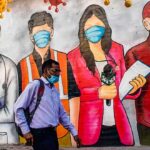R0 values, or the average number of infections expected to be caused by a Covid carrier, vary between states, and have not stabilised.
While unlocking, it would be wise to look at these variations, advises Atanu Biswas.
IMAGE: A thermal imaging camera set up at the deputy commissioner’s office for COVID-19 screening in Dibrugarh district, Assam, July 29, 2020. Photograph: PTI Photo
While India entered into the ‘Unlock 1.0’ stage from June 1 — in a bid to restore normalcy in a phased manner — it is worth evaluating the evolution of the epidemic in the country since the pre-lockdown stage, which passed through four stages.
There is no denying that the economy has to be opened up at some point or the other, in a phased manner.
The appropriate timing, however, is a complex decision, based on various parameters of the epidemic and the economy.
The most important single parameter of the epidemic is R0 (pronounced R-zero or R-nought), which has become a common term during the epidemic.
It is the basic reproduction number, which represents the magnitude of the epidemic.
It is the average (or expected) number of secondary infections generated by an infected person during one’s entire infectious period.
If R0 is greater than one, one infected person will infect more than one, on average, and the outbreak will lead to an epidemic.
R0 less than one implies that one infected individual will infect less than one, and thus the outbreak will eventually become extinct.
When R0 is 1, one infected person will infect exactly one person, and thus the number of those infected would remain constant over time.
And (R0-1)/R0, the ‘herd immunity threshold’, is the proportion of individuals needed to be infected to achieve herd immunity.
The higher R0 is, the greater the number of people that will need to be infected before herd immunity is achieved.
Thus, it is desirable to bring down R0 as much as possible, and that was the main objective of the prolonged lockdown.
We use data on the pre-lockdown period (March 14-24), followed by lockdown 1.0 (March 25-April 14), lockdown 2.0 (April 15-May 3), lockdown 3.0 (May 4-18), and lockdown 4.0 (May 19-31), to obtain the R0 values, assuming a suitable common generating time distribution across the country.
For India as a whole, the pre-lockdown R0 value during March 14-24 was 3.30.
Thus, one infected was infecting nearly another three and one-third, on average, at that stage.
During the four stages of the lockdown, the successive R0 values were 1.57, 1.40, 1.38 and 1.44.
Thus, the epidemic slowed down as soon as the lockdown was imposed.
However, R0 didn’t dip below 1, implying that the epidemic was not declining.
It remained almost stable despite more and more relaxations.
That may encourage more relaxation, eventually “unlocking” the economy through phases.
IMAGE: A health worker collects the sample of an infant for the COVID-19 test in Patna, July 29, 2020. Photograph: ANI Photo
However, such estimates of R0 are subject to error, due to the difficulty in choosing a “suitable” model for a new and unknown disease, and also due to the inadequate number of tests, leading to lots of asymptomatic patients remaining undetected.
Then, again, the 95 per cent confidence interval of the all-India pre-lockdown R0 is (2.86, 3.78).
Thus, even if the model and data are unsatisfactory, there is a 5 per cent chance that the true value will be outside that interval.
And there might be a small yet clear 1 to 2 per cent chance that the actual R0 is too high, but the model and data have failed to estimate it.
It is the standard statistical interpretation of any estimate.
Consequently, there may always be towns or districts where the epidemic will erupt alarmingly, even if the estimated relevant R0 seems under control.
Let’s examine the cases of some states.
Delhi’s estimated pre-lockdown R0 was quite high.
However, in the four lockdown stages it was 2, 1.60, 1.51, and 1.74, respectively.
Thus, a lockdown can reduce R0, although it increased a bit in lockdown 4.0.
In Tamil Nadu, the pre-lockdown R0 (4.20) was surpassed in lockdown 1.0 (8.12).
However, it decreased thereafter; the next three R0 values are: 1.82, 1.87, and 1.44.
Thus, it seems that the lockdown was quite helpful for Tamil Nadu.
The pre-lockdown R0 in Maharashtra was 1.71, and it was 1.76, 1.44, 1.42, and 2.39 in the four stages of lockdown — it’s quite high even at the end of lockdown 4.0.
However, it could possibly be much more if there were no lockdown.
At the end of lockdown 4.0, R0 for Tamil Nadu is very similar to the national value.
While R0 for Goa (1.40) is less than the national value, the values for West Bengal (1.70), Rajasthan (1.63), Karnataka (1.55), and Punjab (1.82) are all above the national average.
IMAGE: Health workers conduct a door to door survey for COVID-19 during a 72-hour lockdown in Agartala, July 28, 2020. Photograph: ANI Photo
Thus, it is clear that R0 values in some states were reasonably under control during the lockdown period, and the values are alarmingly high in some states.
Similar variations will persist even if we look at the data for different towns and districts within a state.
Importantly, as per present trends, there is no sign that the outbreak will become extinct soon.
R0 values in the unlocking period have not stabilised yet.
They may, however, increase as the unlocking rolls on — the “curve” that had flattened due to the prolonged lockdown may become steep again, if we do not adhere to health guidelines.
There is a trade-off between health and the economy everywhere in the world.
Thus, while unlocking, it would be wise to look at the variations within the country, and act accordingly.
The Netherlands termed their lockdown an ‘intelligent lockdown’; let us ‘unlock’ intelligently.
Atanu Biswas is professor of statistics, Indian Statistical Institute, Kolkata.
Feature Presentation: Ashish Narsale/KhabriBaba.com




